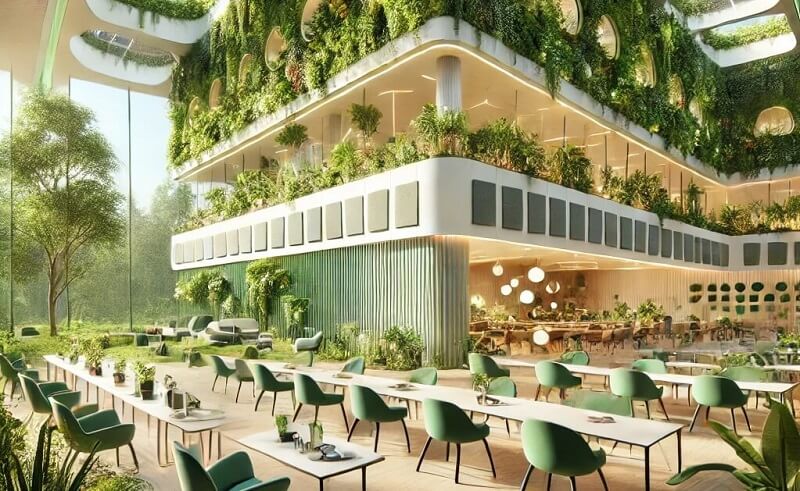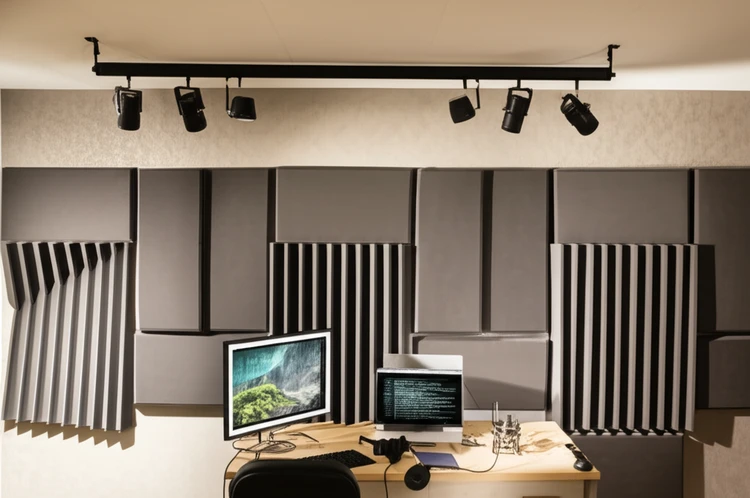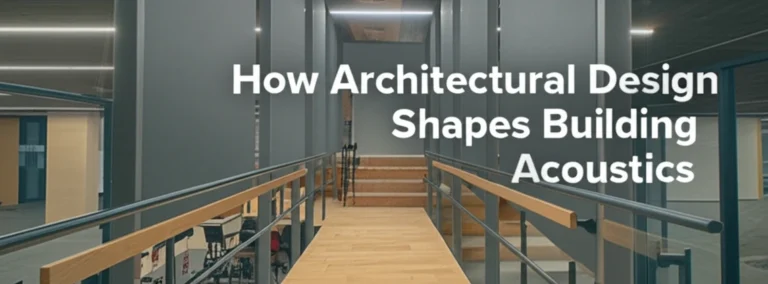
The convergence of sustainability and sound design is revolutionizing the built environment. Understanding how green building practices improve acoustics not only enhances occupant well-being but also contributes to a more environmentally responsible future. By strategically implementing eco-conscious materials and innovative design strategies, we can create spaces that are both sonically pleasing and ecologically sound.
Modern architecture is increasingly embracing sustainability, and a crucial, often overlooked, benefit of this shift is its positive impact on acoustics.
Buildings designed with eco-friendly materials and green strategies not only reduce energy use and minimize carbon footprints, but they also significantly improve sound quality. This article explores the multifaceted ways in which green building practices can enhance architectural acoustics, leading to healthier, more comfortable, and productive environments. By strategically combining natural elements, recycled materials, and cutting-edge innovations, architects can effectively address noise issues while simultaneously promoting a more sustainable and peaceful built environment.
Why Acoustic Performance Matters in Green Building Design
Acoustics play a fundamental role in the functionality and comfort of any building.
Poor sound management can lead to distractions, increased stress levels, reduced productivity, and even negative health impacts in workplaces, schools, and homes. Conversely, well-designed acoustics create a sense of calm, improve communication, and enhance overall well-being. By thoughtfully incorporating acoustic considerations into green building practices, architects can significantly enhance occupant comfort and satisfaction while aligning with broader sustainability goals.
For instance, minimizing the need for artificial soundproofing through the use of inherently sound-absorbent materials reduces reliance on energy-intensive manufacturing processes.
This reduction in manufacturing and transportation aligns perfectly with core eco-friendly design principles and further contributes to a smaller overall environmental impact.
Key Principles of Architectural Acoustics in Green Building
Understanding how green building practices improve acoustics requires a grasp of the core principles of sound behavior within a space. These principles include:
Sound Absorption
Sound absorption is the process by which a material converts sound energy into heat, thereby reducing the amount of sound reflected back into the room. Using materials with high sound absorption coefficients minimizes echo and reverberation, leading to a clearer and more pleasant auditory experience.
Eco-friendly options such as cork, wool, and natural fibers are excellent sound absorbers. For example, wool panels, with a Noise Reduction Coefficient (NRC) ranging from 0.80 to 0.95 (where 1.0 is perfect absorption), are particularly effective in open-plan offices or classrooms where noise control is crucial for concentration and effective communication. Cork, with an NRC typically between 0.20 and 0.35, can contribute to sound dampening when used strategically.
Sound Reflection
Sound reflection is the bouncing of sound waves off surfaces.
Minimizing excessive sound reflection helps avoid unwanted noise buildup and acoustic hotspots. Sustainable surface treatments like bamboo panels or repurposed wood can be used strategically to manage sound reflections.
While these materials may not have exceptionally high absorption coefficients, they can be designed to scatter and diffuse reflections more evenly, creating a more balanced acoustic environment. The surface texture and orientation play a key role in how sound is reflected.
Sound Diffusion
Sound diffusion refers to the scattering of sound waves in multiple directions. Diffusing sound evenly across a space prevents the formation of concentrated areas of noise and creates a more uniform soundscape. Textured, eco-conscious materials like 3D-printed bioplastics or reclaimed wood slats can contribute to sound diffusion.
The irregular surfaces of these materials scatter sound waves, preventing them from focusing in specific areas. This diffusion improves speech intelligibility and creates a more natural and pleasant acoustic environment.
Sustainable Materials for Acoustic Optimization
Natural Materials
Natural materials like wool, cork, and bamboo are versatile, renewable, and demonstrably effective at absorbing sound. Wool panels are particularly popular in office environments for their noise-canceling properties and eco-friendliness.
Bamboo, known for its rapid growth and renewability, serves as a lightweight yet durable acoustic solution, often used in wall paneling and ceiling applications.
Recycled and Repurposed Materials
Recycled materials offer the dual benefit of reducing waste and improving acoustics. Panels made from recycled plastic bottles, denim insulation made from old jeans, or acoustic tiles from recycled rubber are increasingly common in green building projects. Similarly, reclaimed wood, besides providing acoustic balance, adds a unique, rustic aesthetic.
Bio-Based Innovations
New technologies continue to expand the possibilities of sustainable acoustic solutions.
Bio-based materials like mycelium, a fungus-based product, and bioplastics derived from plant materials are increasingly being explored for their acoustic properties. These options are biodegradable and offer promising soundproofing potential, aligning perfectly with sustainable design principles.
Green Roofs and Walls for Acoustic Benefits
Vegetated roofs and walls (also known as living walls) provide more than just aesthetic appeal. They act as natural sound barriers, absorbing and deflecting sound waves, particularly in dense urban environments.
Studies have shown that green roofs can reduce sound transmission by up to 10 decibels. Vertical gardens and green walls further deflect and absorb noise while simultaneously offering insulation benefits. These features also contribute to thermal regulation, improve air quality, and support biodiversity, enhancing both environmental and acoustic performance of a building.
Energy Efficiency and Acoustic Design Synergy
Acoustic and energy-efficient design often go hand in hand. For instance, well-insulated walls designed to retain heat also reduce sound transmission. Properly sealed, double- or triple-glazed windows and doors not only block noise but also enhance energy efficiency by minimizing air leakage, making them essential in both sustainable and acoustic-focused architecture.
Passive design strategies, like orienting buildings to minimize external noise sources (such as traffic) and strategically placing windows to optimize natural daylighting, further integrate these objectives.
Designing for Quiet in Green Spaces
Incorporating quiet zones into urban and residential developments has demonstrable benefits for mental health and overall well-being.
Parks and urban forests soften city soundscapes by absorbing and masking noise, creating tranquil environments that offer respite from the constant din of urban life. Architects can enhance these spaces using green building techniques, such as planting a diverse range of sound-absorbing vegetation and strategically using natural barriers like earth berms and densely planted hedges to further reduce urban noise intrusion.
Innovative Technologies in Sustainable Acoustics
Emerging technologies are constantly pushing the boundaries of sustainable acoustics. Here are a few examples:
- 3D-Printed Acoustic Panels: These panels, created from recycled or bio-based materials, offer custom acoustic solutions for complex spaces, allowing for precise control over sound absorption and diffusion.
- Smart Acoustic Panels: These advanced systems can adapt to changing noise levels in real-time, optimizing the acoustic environment based on occupancy and activity levels.
They can be powered by renewable energy sources to further minimize their environmental impact.
- IoT Monitoring Devices: Internet of Things (IoT) sensors can track and manage noise pollution levels, providing valuable data that architects and building managers can use to implement data-driven acoustic solutions and optimize the soundscape of a space.
Green Buildings with Superior Acoustics: Case Studies
The Edge, Amsterdam
The Edge, renowned for its energy efficiency, also incorporates soundproof materials and smart technologies to create a productive and comfortable workspace. Specifically, the building uses high-performance glazing to minimize external noise intrusion and strategically placed acoustic baffles and sound-absorbing panels in open-plan areas to control reverberation and enhance speech privacy.
This integrated approach to acoustic design reflects a commitment to both sustainability and occupant well-being.
Bosco Verticale, Milan
This “Vertical Forest,” with its integrated trees and plants, not only provides a striking visual but also utilizes the vegetation to absorb noise and improve air quality.
The dense foliage acts as a natural sound barrier, mitigating the effects of traffic and other urban noise sources. The integration of plants within the structure exemplifies how green building practices can be seamlessly integrated to enhance a building’s acoustic performance.
Bullitt Center, Seattle
The Bullitt Center, often touted as one of the greenest commercial buildings in the world, combines renewable energy sources with innovative soundproofing measures. The building’s design incorporates high-performance windows and insulation to minimize noise transmission, while interior spaces utilize natural materials like wood and recycled content for their acoustic properties.
This integrated approach showcases the seamless alignment of sustainability and acoustics in a high-performance building.
FAQ
How do green building materials improve acoustics?
Eco-friendly materials like cork, bamboo, recycled textiles, and sheep’s wool absorb sound effectively due to their porous structure and fibrous composition, dissipating sound energy as heat. Choosing these sustainable options over synthetic alternatives promotes both acoustic optimization and reduces environmental impact.
Can green roofs and walls reduce noise pollution?
Yes, vegetated roofs and walls act as natural sound barriers, absorbing and deflecting outdoor noise, especially in urban areas. The soil and plant layers dampen sound waves, creating a quieter indoor environment while simultaneously offering other environmental benefits like improved thermal regulation and enhanced air quality.
What are cost-effective sustainable options for acoustic design?
Many affordable solutions combine effective noise control with eco-consciousness.
Recycled acoustic panels, cork tiles, repurposed wood, and even strategically placed curtains made from natural fibers can significantly improve the acoustics of a space without a large financial investment.
Conclusion
Sustainable and green building practices are fundamentally transforming the field of architectural acoustics, delivering demonstrably improved sound quality alongside significant environmental benefits.
By integrating natural and recycled materials, innovative technologies, and thoughtful design strategies, architects can create spaces that are not only environmentally responsible but also acoustically superior. Prioritizing sustainable acoustics is not just a trend; it’s a crucial step towards ensuring healthier, more productive, and enjoyable environments for everyone.
Embracing these practices makes a lasting positive impact on both the planet and the soundscapes of our built spaces, contributing to a more sustainable and harmonious future.






